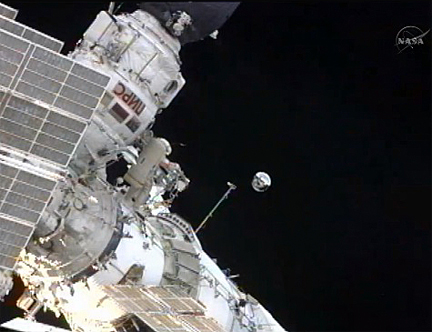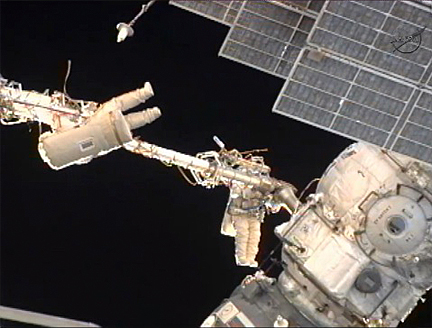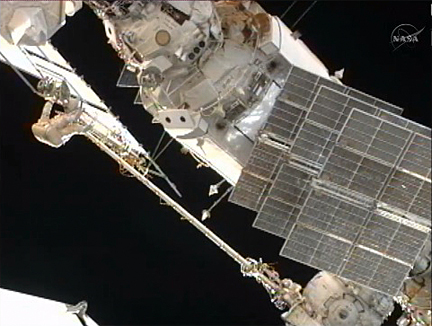Cosmonauts walk in space to move crane, deploy satellite (UPDATED)
Editor's note...
CBS News
Space station commander Gennady Padalka and cosmonaut Yuri Malenchenko floated out of the Pirs docking compartment Monday and had no problems completing the primary objective of a five-hour 51-minute spacewalk, moving a telescoping space crane to a different module in preparation for arrival of a Russian laboratory compartment late next year.
The cosmonauts then launched a small science satellite, using a handling tool to manually deploy the 20-pound spacecraft on a trajectory to the rear of the space station.
"Nice throw. Beautiful! Really beautiful!" a translator in the Russian mission control center relayed from air-to-ground radio traffic as the satellite drifted away. "And you can see the sun is being reflected, it's absolutely gorgeous."
The cosmonauts then completed the final major objective of the spacewalk, installing five micrometeoroid shields on the Zvezda command module. They also retrieved a small space exposure experiment and installed two support struts on a ladder used by spacewalkers.
Padalka and Malenchenko returned to the Pirs docking compartment and closed the hatch at 5:28 p.m. EDT (GMT-4) to officially end the excursion.
This was the 163rd spacewalk devoted to station assembly and maintenance since construction began in 1998, the second so far this year, the ninth for Padalka and the fifth for Malenchenko. One hundred and one astronauts and cosmonauts have now logged 1,027 hours and 38 minutes -- nearly 43 days -- conducting space station EVAs.
If all goes well, NASA astronaut Sunita Williams and Japanese crewmate Akihiko Hoshide will stage a U.S. spacewalk on Aug. 30. The goals of that outing, the first by a U.S. astronaut since the final shuttle flight last summer, are to replace a critical electrical distribution box and to route cables needed by the Russian laboratory module scheduled for launch late next year.
Today's spacewalk, Russian EVA-31, began at 11:37 a.m. when Malenchenko and Padalka opened the hatch of the Pirs docking and airlock module. For identification, Padalka, call-sign EV-1, was wearing a Russian Orlan spacesuit with red stripes. Malenchenko, EV-2, was wearing a suit with blue stripes.
To protect against the possibility of a problem that might prevent a normal return to the station, internal hatches were closed and NASA astronaut Joseph Acaba and cosmonaut Sergei Revin spent the day isolated in the Poisk docking compartment where the Soyuz TMA-04M spacecraft is docked.
Williams and Hoshide were isolated in the forward part of the station, with access to the Soyuz TMA-05M ferry craft docked to the Rassvet module attached to the Russian Zarya propulsion and storage module.
Today's spacewalk began nearly an hour behind schedule because of troubleshooting to track down a small leak. Russian flight controllers, assisted by Hoshide, resolved the problem and the spacewalkers were cleared to proceed with the Pirs depressurization.
The first item on the agenda was the relocation of the Strela 2 crane from its mounting point on the Pirs compartment to the forward Zarya module. The manually operated telescoping cranes are used to move cargo and spacewalkers from one point to another during EVAs.
The Pirs module will be discarded late next year to make way for the attachment of the new Russian laboratory module. Padalka and Malenchenko had no problems detaching the Strela 2 crane and moving it into position using an identical appendage, Strela 1, that is attached to the Poisk docking compartment on the upper side of the Zvezda module.
"Wow. what a beautiful view," one of the cosmonauts marveled at one point as the station approached the western coast of South America.
The crane relocation took about two hours to complete, with Malenchenko, operating Strela 1, moving Padalka and the folded Strela 2 boom from Pirs to its new mounting point. Both cosmonauts worked together to bolt the crane in place and then Malenchenko returned to Poisk to rotate Strela 1, and Padalka, back to the crane's stowage position.
Padalka attempted to retrieve a materials science experiment, but the experiment package would not fold up properly and the cosmonaut left it in place. He and Malenchenko then manually launched the small Sphera satellite. The reflective satellite was pushed away to the rear of the station and is expected to stay in orbit for about three months. The goal of the experiment is to verify mathematical models to help with long-term predictions of space debris trajectories.
The final major objective of the spacewalk was installing five micrometeoroid shields around the forward section of the Zvezda command module. The cosmonauts had no problems and successfully attached all five panels. Running well ahead of schedule, they completed two so-called "get-ahead" tasks, attaching two struts to an EVA ladder and retrieving another external experiment.
- Posted at 11:51 AM EDT, 08/20/12: Cosmonauts leave space station for 6.5-hour EVA
- Updated at 12:40 PM EDT, 08/20/12: Adding pictures
- Updated at 02:00 PM EDT, 08/20/12: Cargo boom attached to Zarya
- Updated at 03:00 PM EDT, 08/20/12: Satellite launched
- Updated at 05:45 PM EDT, 08/20/12: Debris shields installed; spacewalk ends
CBS News
Space station commander Gennady Padalka and cosmonaut Yuri Malenchenko floated out of the Pirs docking compartment Monday and had no problems completing the primary objective of a five-hour 51-minute spacewalk, moving a telescoping space crane to a different module in preparation for arrival of a Russian laboratory compartment late next year.
 |
| Cosmonaut Gennady Padalka launched a small basketball-size satellite during a spacewalk Monday. (Credit: NASA TV) |
"Nice throw. Beautiful! Really beautiful!" a translator in the Russian mission control center relayed from air-to-ground radio traffic as the satellite drifted away. "And you can see the sun is being reflected, it's absolutely gorgeous."
 |
| Malenchenko, right, operates the Strela 2 crane to move Padalka, left, and the Strela 1 boom to its new location on the forward Zarya module. (Credit: NASA TV) |
Padalka and Malenchenko returned to the Pirs docking compartment and closed the hatch at 5:28 p.m. EDT (GMT-4) to officially end the excursion.
 |
| Padalka, on the end of the telescoping Strela 1 cargo crane, is moved into position to attach the folded Strela 2 boom to the Zarya module. Fellow spacewalker Malenchenko is visible behind the base of the Strela 1 boom on the right. (Credit: NASA TV) |
If all goes well, NASA astronaut Sunita Williams and Japanese crewmate Akihiko Hoshide will stage a U.S. spacewalk on Aug. 30. The goals of that outing, the first by a U.S. astronaut since the final shuttle flight last summer, are to replace a critical electrical distribution box and to route cables needed by the Russian laboratory module scheduled for launch late next year.
Today's spacewalk, Russian EVA-31, began at 11:37 a.m. when Malenchenko and Padalka opened the hatch of the Pirs docking and airlock module. For identification, Padalka, call-sign EV-1, was wearing a Russian Orlan spacesuit with red stripes. Malenchenko, EV-2, was wearing a suit with blue stripes.
To protect against the possibility of a problem that might prevent a normal return to the station, internal hatches were closed and NASA astronaut Joseph Acaba and cosmonaut Sergei Revin spent the day isolated in the Poisk docking compartment where the Soyuz TMA-04M spacecraft is docked.
Williams and Hoshide were isolated in the forward part of the station, with access to the Soyuz TMA-05M ferry craft docked to the Rassvet module attached to the Russian Zarya propulsion and storage module.
Today's spacewalk began nearly an hour behind schedule because of troubleshooting to track down a small leak. Russian flight controllers, assisted by Hoshide, resolved the problem and the spacewalkers were cleared to proceed with the Pirs depressurization.
The first item on the agenda was the relocation of the Strela 2 crane from its mounting point on the Pirs compartment to the forward Zarya module. The manually operated telescoping cranes are used to move cargo and spacewalkers from one point to another during EVAs.
The Pirs module will be discarded late next year to make way for the attachment of the new Russian laboratory module. Padalka and Malenchenko had no problems detaching the Strela 2 crane and moving it into position using an identical appendage, Strela 1, that is attached to the Poisk docking compartment on the upper side of the Zvezda module.
"Wow. what a beautiful view," one of the cosmonauts marveled at one point as the station approached the western coast of South America.
The crane relocation took about two hours to complete, with Malenchenko, operating Strela 1, moving Padalka and the folded Strela 2 boom from Pirs to its new mounting point. Both cosmonauts worked together to bolt the crane in place and then Malenchenko returned to Poisk to rotate Strela 1, and Padalka, back to the crane's stowage position.
Padalka attempted to retrieve a materials science experiment, but the experiment package would not fold up properly and the cosmonaut left it in place. He and Malenchenko then manually launched the small Sphera satellite. The reflective satellite was pushed away to the rear of the station and is expected to stay in orbit for about three months. The goal of the experiment is to verify mathematical models to help with long-term predictions of space debris trajectories.
The final major objective of the spacewalk was installing five micrometeoroid shields around the forward section of the Zvezda command module. The cosmonauts had no problems and successfully attached all five panels. Running well ahead of schedule, they completed two so-called "get-ahead" tasks, attaching two struts to an EVA ladder and retrieving another external experiment.